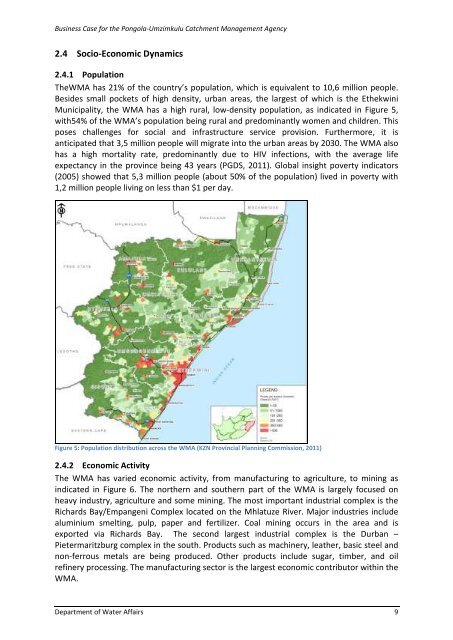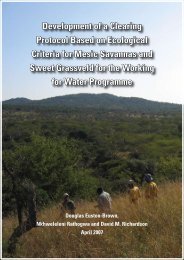Business Case forthe Pongola-Umzimkulu Catchment Management ...
Business Case forthe Pongola-Umzimkulu Catchment Management ...
Business Case forthe Pongola-Umzimkulu Catchment Management ...
You also want an ePaper? Increase the reach of your titles
YUMPU automatically turns print PDFs into web optimized ePapers that Google loves.
<strong>Business</strong> <strong>Case</strong> for the <strong>Pongola</strong>-<strong>Umzimkulu</strong> <strong>Catchment</strong> <strong>Management</strong> Agency<br />
2.4 Socio-Economic Dynamics<br />
2.4.1 Population<br />
TheWMA has 21% of the country’s population, which is equivalent to 10,6 million people.<br />
Besides small pockets of high density, urban areas, the largest of which is the Ethekwini<br />
Municipality, the WMA has a high rural, low-density population, as indicated in Figure 5,<br />
with54% of the WMA’s population being rural and predominantly women and children. This<br />
poses challenges for social and infrastructure service provision. Furthermore, it is<br />
anticipated that 3,5 million people will migrate into the urban areas by 2030. The WMA also<br />
has a high mortality rate, predominantly due to HIV infections, with the average life<br />
expectancy in the province being 43 years (PGDS, 2011). Global insight poverty indicators<br />
(2005) showed that 5,3 million people (about 50% of the population) lived in poverty with<br />
1,2 million people living on less than $1 per day.<br />
Figure 5: Population distribution across the WMA (KZN Provincial Planning Commission, 2011)<br />
2.4.2 Economic Activity<br />
The WMA has varied economic activity, from manufacturing to agriculture, to mining as<br />
indicated in Figure 6. The northern and southern part of the WMA is largely focused on<br />
heavy industry, agriculture and some mining. The most important industrial complex is the<br />
Richards Bay/Empangeni Complex located on the Mhlatuze River. Major industries include<br />
aluminium smelting, pulp, paper and fertilizer. Coal mining occurs in the area and is<br />
exported via Richards Bay. The second largest industrial complex is the Durban –<br />
Pietermaritzburg complex in the south. Products such as machinery, leather, basic steel and<br />
non-ferrous metals are being produced. Other products include sugar, timber, and oil<br />
refinery processing. The manufacturing sector is the largest economic contributor within the<br />
WMA.<br />
Department of Water Affairs 9
















